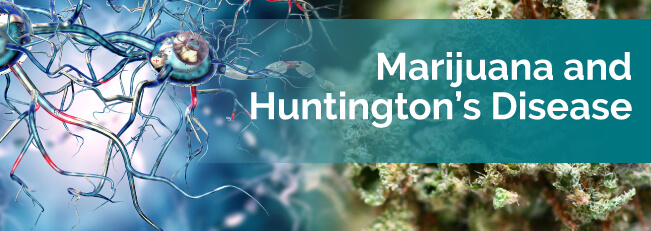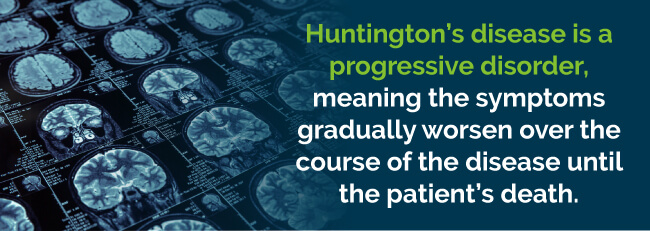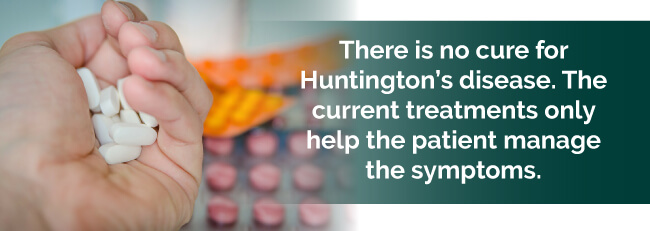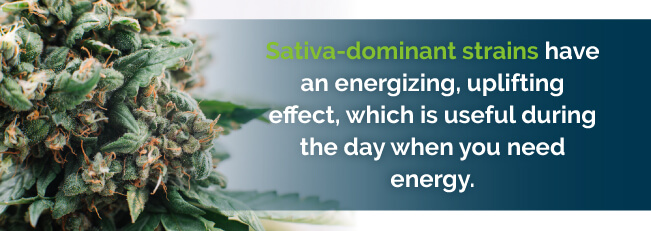
Huntington’s disease is a progressive, fatal disease caused by a hereditary gene defect. No cure exists, and many of the medications used to relieve the symptoms cause unpleasant side effects or worsening symptoms. While cannabis for Huntington’s disease is not a cure, it may offer some relief of symptoms without the negative side effects.
Huntington’s disease is a fatal genetic disease that affects the patient’s functioning, both physically and cognitively. It affects the nerves in the brain, which progressively break down over time.
Huntington’s disease stems from a gene defect. You only need one copy of the defective gene for the disease to occur. If a parent has the defective gene that causes Huntington’s disease, each child in the family has a 50/50 chance of inheriting the defective gene. About 30,000 Americans show symptoms of the disease. Another 200,000 are at risk of inheriting Huntington’s disease.

Huntington’s disease is a progressive disorder, meaning the symptoms gradually worsen over the course of the disease until the patient’s death. The decline progresses differently for each patient. The typical time range is 10 to 30 years from the onset of the disease until death. Tragically, patients with juvenile Huntington’s disease typically die within ten years of the disease onset.
The signs of Huntington’s disease typically develop in the 30s or 40s. However, the disease onset sometimes starts earlier. Juvenile Huntington’s disease is considered a situation when the onset occurs before age 20. About ten percent of Huntington’s disease cases occur in children or adolescents. The symptoms may be slightly different for a patient with early onset. The disease may also progress faster in those early onset situations.
The symptoms of the condition fall into three main categories: movement, cognitive and psychiatric. The symptoms are often wide-ranging within each of the categories, and they don’t always present in the same order in all patients.
Movement symptoms of the disease include:
These physical symptoms interfere with normal activities. Involuntary movements can cause problems, but patients also have difficulty functioning as they lose the ability to control their voluntary movements.
Cognitive symptoms often include:
Psychiatric symptoms can include:
Juvenile Huntington’s disease may have additional or slightly different symptoms. Some of those symptoms include:
In addition to the symptoms of the disease, patients diagnosed with Huntington’s disease have an increased risk of suicide. The risk is highest before the official diagnosis and when the person begins losing independence.
Because it is a progressive disorder, patients with Huntington’s disease gradually lose functioning. This leads to a loss of independence. Patients eventually need help with all functions and are confined to bed. While late-stage patients often cannot speak, they do have an awareness of friends and family and can often still understand language.
The actual cause of death tends to be from complications due to the disease. These causes might include pneumonia, other infections, fall-related injuries, heart disease or as the result of being unable to swallow.
The progression of Huntington’s disease is often described in three general phases. The symptoms and the speed of progression may vary, but patients move through the same three phases eventually.
The first stage, sometimes called early stage Huntington’s disease, describes subtle changes during the initial onset. The patient may have some difficulty with coordination and involuntary movements. The symptoms start to have an impact on the patient’s life, including work and home activities.
The middle stage causes an increase in movement problems. The patient may begin losing speech and having difficulty swallowing. Therapists may become involved to help deal with the continued progression of the disease. The patient has more difficulty handling regular activities.
The late stage is described as the period when the patient depends on others for care. Symptoms become very severe, with a high risk of choking. At this stage, the patient is often unable to talk or walk.
Diagnosis often occurs with a thorough physical exam and family history. Neurological and psychiatric exams are also used in the diagnosis process. A neurologist may perform tests to check reflexes, muscle strength and tone, coordination, balance, sense of touch, vision and hearing and mood. Standardized tests are sometimes used to check for issues with memory, reasoning, language function and spatial reasoning.
A psychiatrist may perform an assessment to look at things like a patient’s emotional state, behavior, judgment, coping and the presence of disordered thinking. In some cases, imaging tests may be used to evaluate the brain. MRIs and CTs are often used to look for changes in the structure of the brain at key spots. These imaging tests can help rule out other potential cause of the symptoms.
Genetic testing is another option. The testing looks for the defective gene and can be helpful if there isn’t a known history of the disease in your family. Genetic testing can be performed on a patient with no symptoms if there is a family history of the disease.
The testing can determine if the defective gene is present. Some people feel better knowing whether they have the genetic marker, while others may feel more stress if they find out they do have the defective gene. Some people with a risk of the disease do the testing before having kids.
There is no cure for Huntington’s disease. The current treatments and medication option only help the patient manage the symptoms. The progressive decline in functioning continues even with medication with no change in the course of the disease.

The progressive nature of Huntington’s disease means the medication used may change over the course of the disease. Many of the drugs used to treat the condition may actually worsen the symptoms or cause additional side effects. Adjusting medications to minimize those effects is also part of the treatment process.
Some of the medications used to treat Huntington’s disease include:
In addition to medications, patients often receive various types of therapy to handle the disease. Those therapies may include:
Because there is no known cure for Huntington’s disease, medical treatment focuses on allowing the patient to live as normal a life as possible. One aspect of treatment is to reduce anxiety.
Not only does the disease itself tend to produce a variety of psychiatric conditions that include anxiety symptoms, but simply knowing you suffer from a fatal disease can, understandably, produce stress and anxiety. Medical marijuana has been proven to reduce anxiety in numerous clinical studies.
While anti-depressants, anti-anxiety and anti-seizure drugs are often prescribed for a sufferer of Huntington’s disease, each of these drugs comes with a host of possible negative side effects. Aside from the possibility of overdose, these drugs carry a high risk of dependency and addiction as well. They may cause nausea, insomnia or gastrointestinal problems.
Worse still, many of these drugs can actually cause, or contribute to the worsening of, depression or other psychiatric conditions.
Medical marijuana, on the other hand, does not carry with it many of these negative side effects, yet it may help to reduce tension and anxiety as well as help reduce nausea, restlessness or insomnia. Researchers believe Huntington’s disease may be strongly connected to the body’s endocannabinoid system, which responds to the cannabinoids in marijuana. That connection could aid in relief found from using marijuana for Huntington’s disease.
Dystonia, which is often associated with Huntington’s disease, can cause pain. Medical cannabis is a known pain reliever, which can help ease the discomfort felt by the patient. Marijuana often minimizes feelings of nausea, and it tends to stimulate the appetite. Patients with Huntington’s disease often have a loss of appetite and lose weight as the disease progresses. That appetite stimulation may help combat that symptom of the disease in some patients.

CBD, a cannabinoid found in medical marijuana, may have a neuroprotective effect on the brain. Huntington’s disease seems to react positively to neuroprotective drugs, which means CBD could have a positive effect on the disease as well. CBD has an antioxidant quality that shows signs of helping neurons. Strains that combine TCH and CBD may have an even stronger neuroprotective effect.
THC may also minimize the jerky movements associated with Huntington’s disease. Reducing those movements can provide relief and make it easier to complete normal tasks. Indica-dominant strains of marijuana cause a sense of sleepiness, which is useful for Huntington patients who feel restless or suffer from insomnia. If fatigue is an issue, Sativa-dominant strains can create an uplifting effect.
Cannabis can be effective in not only treating the symptoms of Huntington’s disease, but it can also counteract the side effects of medication taken for the disease. For this reason, some people use marijuana even if they take other prescription drugs for the condition.
Specific research on cannabis and Huntington’s disease is limited. This is due primarily to the difficulty researchers have in getting marijuana to use for research since it is a Schedule 1 drug. Federal regulations can make research challenging. However, other general studies related to the effects of marijuana can help give a picture of how it might help with Huntington’s disease.
The tension-reducing effects of medical marijuana are well known. Numerous studies have been done that show the possible beneficial use of medical marijuana for patients who suffer from tension or anxiety. Cannabidiol, or CMD, is a chemical component found in marijuana and widely believed to be responsible for some of the beneficial effects of marijuana.
A recent study looked at the benefits of medical marijuana on patients suffering from Huntington’s disease and found the participants showed a modest improvement of symptoms, which increased with the amount of the drug they received.
Even more promising results were obtained in an animal study. In that study, a mutant strain of hamsters that exhibited the symptoms of dystonia, a sub-group of disorders that share similar characteristics to Huntington’s disease, were given a synthetic cannabinoid that activates the same cellular receptors as THC.
The hamsters showed symptoms of dystonia that included rapid, jerky movements or slow, repetitive movements, similar to Huntington’s disease sufferers. In that study, the hamsters showed a marked reduction of symptoms when under the influence of the synthetic cannabinoid, indicating that medical marijuana may be beneficial to those with Huntington’s disease.
Medical marijuana comes in many different strains with different effects on the body. The two primary types of marijuana are Indica and Sativa. Both can be effective in treating different symptoms of Huntington’s disease. Indica-dominant strains have a sedative or drowsy effect on the user, which is beneficial for nighttime use or for patients with insomnia.
Sativa-dominant strains have an energizing, uplifting effect, which is useful during the day when you need energy.

Ingestion methods can also vary depending on your preference. Here are the options:
Prescription drugs used to manage the symptoms of Huntington’s disease often have severe, unpleasant side effects. They may manage some symptoms, but they often worsen others or cause new side effects. Marijuana is an alternative option with very few side effects. The effects you feel when using marijuana are generally minimal with no long-term effects.
Many of the side effects are actually beneficial to people who are suffering from Huntington’s disease. Those potential side effects include:
Huntington’s disease is a devastating condition with no known cure, but medical cannabis may provide some relief of the symptoms to provide an improved quality of life. It is an affordable, natural alternative for treating many symptoms. If you or a loved one suffers from Huntington’s disease and would like to explore the possibility of treating the symptoms with medical marijuana, we can help.
We can help you find a qualified marijuana doctor in any legal marijuana state and ensure you follow all state laws for compliance. Find a doctor today to explore the use of marijuana for Huntington’s disease relief.
For more information about how cannabis can be used to treat Huntington’s Disease, check out our resources:
Find A Doctor Find A Dispensary